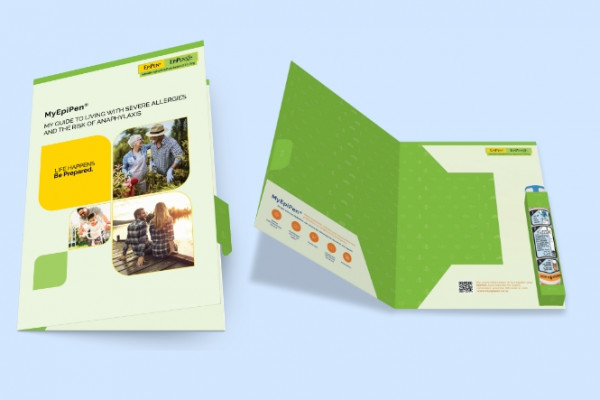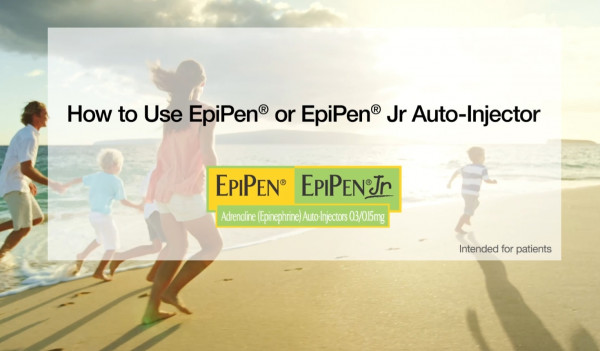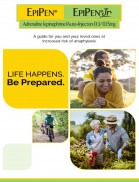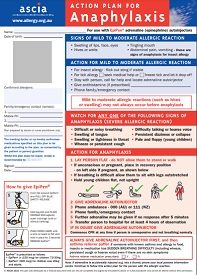Wishing everyone a safe and happy Christmas and New Year – Meri Kirihimete from the Healthify team.
EpiPen®
Also called adrenaline (epinephrine) auto-injector
Key points about EpiPen
- An EpiPen® is used in allergic emergencies that can be life-threatening.
- EpiPen auto-injectors are designed for immediate treatment of a severe allergic reaction, also called anaphylaxis.
- Find out how to use it safely and possible side effects.

An EpiPen® is an auto-injector device that has a pre-filled syringe fitted with a needle and contains a single dose of adrenaline (also called epinephrine) for injection into your muscle. It's used in an emergency to quickly treat anaphylaxis – see signs of anaphylaxis.
EpiPen auto-injectors are easy to use and can be used by anyone – parents, caregivers, passers-by or the allergic person themselves (if they're able to).
The EpiPen is designed for emergency first-response therapy only and isn't a replacement for emergency medical or hospital care. You must still call an ambulance (on 111) or be taken to hospital for observation, even if you feel much better.
Each EpiPen contains a pre-measured dose of adrenaline and can only be used once.
In Aotearoa New Zealand, there are 2 strengths of EpiPen® with different amounts of adrenaline in them.
- EpiPen: 300 micrograms (for people weighing more than 30 kg)
- EpiPen Junior: 150 micrograms (for children weighing 15 to 30 kg).
Note: The Australian dosing guidelines below are slightly different and some New Zealand organisations use them:
- EpiPen: 300 micrograms (for people weighing more than 20 kg)
- EpiPen Junior: 150 micrograms (for children weighing 7.5 to 20 kg).
Your healthcare provider will choose the most appropriate dose of EpiPen based on your weight and careful medical assessment of your severe allergic reaction.
In Aotearoa New Zealand, an EpiPen® can be prescribed by your healthcare provider or you can buy it directly from a pharmacy, without a prescription.
From 1 February 2023, you can get 2 EpiPen auto-injectors funded on a prescription if:
- you have ever experienced an anaphylactic reaction and gone to a hospital or emergency department, or
- you've been assessed by your healthcare provider as being at high risk of having an anaphylactic reaction.
If you have used your device, or your device is going to expire soon, it’s important to get a new prescription for another EpiPen straight away. Replacement EpiPen auto-injectors are also fully-funded.
Here are some things to know when you have an EpiPen®. Other things may be important as well, so ask your healthcare provider what you should know about.
- Have an action plan: Ask your healthcare provider about an action plan that tells you or others what to do if you're having a severe allergic reaction – see an action plan for anaphylaxis.
- Be prepared: Make sure you and your close friends and family know in advance what symptoms to look for, how to use your EpiPen® and where your EpiPen is kept.
- Carry your EpiPen with you at all times: Pouches are available to keep your EpiPen auto-injectors in. When you’re travelling by plane, carry your EpiPen on you or in your hand luggage. Read more travel plan anaphylaxis(external link) and travelling with allergy checklist(external link).
- Check the expiry date of your EpiPen: The expiry date is printed on the side of the EpiPen device. Get a new EpiPen before your old one expires and record the expiry date on your calendar as a reminder or sign up to the MyEpiPen(external link) reminder service to help remind you when your EpiPen is about to expire. Note: In the event of a severe allergic reaction, it's better to use an out-of-date EpiPen than nothing at all.
- Storage: Store your EpiPen at room temperature Don't store it in sunlight, in the glove compartment of your car or anywhere it may get too hot, or in the fridge which is too cold.
- EpiKit: An EpiKit is a toolkit to help patients better understand and manage their anaphylaxis. You can order an EpiKit for free by registering your EpiPen on MyEpiPen(external link). The EpiKit includes:
-
- an EpiPen trainer pen for practicing how to use the device
- A link to register your EpiPen auto-injectors and receive reminders when your EpiPen is about to expire
- Information on Anaphylaxis including action plans to follow in case of an allergic reaction.
 Image credit:Viatris (with permission), NZ, 2024
Image credit:Viatris (with permission), NZ, 2024
- Some people may need to carry more than 1 EpiPen: You may need to carry 2 EpiPen auto-injectors if you:
-
- are very overweight
- have had previous near-fatal anaphylaxis
- have needed multiple doses for previous anaphylactic reactions
- are going to be quite a long way away from any medical help, eg, on a boat/ship or tramping in a remote location.
-
EpiPen auto-injectors are for use in people who have been assessed and advised by their healthcare provider as needing an EpiPen to treat their severe allergic reaction caused by food, medicines, insects, latex or other allergens.
Anaphylaxis is the most severe form of allergic reaction that can be life-threatening. It usually occurs almost immediately (within minutes and up to 2 hours) after exposure to a food, medicine or insect sting to which a person is allergic.
Anaphylaxis must be treated as a medical emergency requiring immediate treatment with adrenaline. Signs of anaphylaxis:
|
Learn how to use an EpiPen BEFORE a severe allergic reaction causes a medical emergency. Ask your healthcare provider for advice on how to use the EpiPen.
The EpiPen has a hidden needle to help people overcome any fear of needles. The needle is very fine so the injection doesn't usually hurt.
It's injected into the thigh muscle and can be used through clothes (even jeans), but it's best to avoid seams and pockets.
Read more about how to use an EpiPen English)(external link), Māori(external link), Samoan)(external link), Tongan(external link) and other languages(external link).
Video: How to use EpiPen® or EpiPen® Jr auto-injector
 (external link)(With permission from Viatris, NZ, 2023)
(external link)(With permission from Viatris, NZ, 2023)
After you have used the EpiPen:
- Phone or ask someone to phone an ambulance on 111 (in Aotearoa New Zealand) and tell the operator you’re having anaphylaxis and have used adrenaline.
- Don't sit upright if you feel lightheaded or dizzy.
- Lie down and wait for the ambulance.
- Record the time the injection was given and take the used EpiPen with you to the emergency room.
Each EpiPen can only be used once. After it's been used, put it back in its container and give it to your healthcare provider or hospital staff who will dispose of it for you.
EpiPen(external link) Medsafe Consumer Information Sheet, NZ
EpiPen Junior(external link) Medsafe Consumer Information Sheet, NZ
Resources
A guide for people at risk of anaphylaxis [PDF, 6.9 MB] Viatris, NZ
Action plan for anaphylaxis – for use with EpiPen adrenaline autoinjectors(external link) Australasian Society of Clinical Immunology and Allergy, Australia
How to use an EpiPen English(external link), Māori(external link), Samoan(external link), Tongan(external link) and other languages(external link) Australasian Society of Clinical Immunology and Allergy, Australia
References
- EpiPen(external link) Auckland DHB Clinical Immunology and Allergy, NZ
- Adrenaline(external link) NZ Formulary
- Adrenaline(external link) New Zealand Formulary for Children
- Self-administration of adrenaline (epinephrine)(external link) New Zealand Formulary for Children
Brochures

Viatris, NZ, 2023

Australasian Society of Clinical Immunology and Allergy, Australia, 2023

Medicines and side effects
Healthify He Puna Waiora, NZ, 2024
Credits: Sandra Ponen, Pharmacist, Healthify He Puna Waiora. Healthify is brought to you by Health Navigator Charitable Trust.
Reviewed by: Stephanie Yee, Pharmacist, Auckland
Last reviewed:





